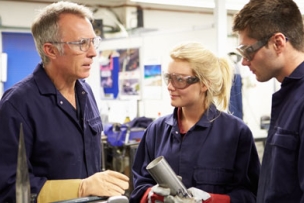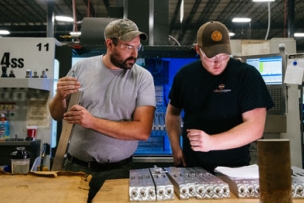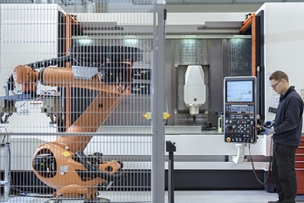Forget the naysayers. U.S. manufacturing remains strong, creating solid demand for workers in these four metal fabrication sectors.
Anyone who listens to the news might swear manufacturing has fled the United States. Anyone who listens to the truth, however, knows manufacturing never left and is here to stay. In fact, the most significant challenge is not in the number of jobs but in the considerable gap that exists between many of the domestic manufacturing openings and the number of proficient workers required to fill them.
“Over the next decade nearly 3.5 million manufacturing jobs will likely need to be filled, and what our skills-gap study with Deloitte found is that there are only about 1.5 million workers prepared to fill them,” says Brent Weil, senior vice president for education and workforce at the Manufacturing Institute, a nonprofit dedicated to studying and solving the skills-gap problem in manufacturing.
“What manufacturers tell us is that they mostly need workers with proper certifications and training,” says Leah Palmer, executive director of the Arizona Advanced Manufacturing Institute at Mesa Community College.
For metal-fabrication workers willing to get the necessary training and certifications, the future looks bright, especially in key industries. Here are some of the fastest-growing sectors for motivated metalworkers.
Metalworking Jobs in Electronics
Electronic devices are growing faster, sleeker and more powerful partly because of the demand for smaller, faster and better products. The processes surrounding their production remains the same—forging, stamping, bending, forming and machining—but the output now includes tiny circuit boards and assorted nanocomponents. Manufacturing methods and technology have to evolve to keep up with these demands as does the expertise needed to execute them. Metalworkers making these components should remain flexible and open to furthering their knowledge set.
“We see students working in the electronic industry repeatedly coming back to get new skills,” says Palmer. “They have to have great foundational skills to start with, but then always be open to upskilling.”
Automotive Careers in Metalworking
Additive manufacturing technicians will be in demand, and some companies will even offer apprenticeships. Additive manufacturing—3D printing—is expected to revolutionize the way cars are made. SmarTech Publishing recently released a report that indicates that by 2021, the auto industry will spend up to $2.3 billion on software, materials and services related to 3D printing.
Since additive manufacturing is so time-intensive, it’s mainly being used for prototyping small batches of parts and tools. For example, Ford used additive manufacturing to create tools to fix a brake noise that suddenly started shortly before the new Ford Explorer was set to launch. If not for the technology, the company would have had a four-month delay in promoting the vehicle. Results such as that mean that only more complicated examples of additive manufacturing are expected, particularly using materials including composites, plastics and, yes, metal.
Thanks to fuel-efficiency requirements, today’s cars have auto transmissions with eight, nine, even 10 speeds. “And as gear counts move toward double digits, that’s good news for the metalworking industry,” says Jim Sawyer, the Detroit-based editor of Manufacturing Engineering magazine. Entire plants have opened with workers who are trained in gear-making processes—hobbing, turning, chamfering, heat treating, hard turning, bore honing and grinding—to machine and supply transmissions that will ultimately allow for smaller, more economical engines.
Alternative Energy Jobs in Metal Fabrication
The International Energy Agency predicts that renewables will be the largest source of new power globally through 2020 because of demand encouraged by reductions in costs for wind and solar. Furthermore, green energy has just benefited from an extension of the production tax credit and the investment tax credit, two incentives to encourage investing in and producing clean energy.
This is all good news for metalworkers, who will be needed to fabricate and maintain the parts of massive turbine towers, says Sawyer. Metal components constitute about 90 percent of the weight of a wind turbine, including the generator and gearbox assemblies, bearings, electronic systems and fasteners.
Automated Food Industry Jobs in Metalwork
Instead of getting stuck thinking that automation only replaces humans, we should start thinking about the ways automation works alongside humans, says Weil. Somebody has to fabricate and maintain all that complicated equipment used in the automated production, for example, of your favorite snack crackers or chocolate bars. In the food-production process, machines, including conveyor belts, grinders, homogenizers and slicers, require sophisticated design and fabrication. The marketing research firm Freedonia Group predicted global sales of automated food-processing machinery would reach $53 billion in 2016.
“I talk to manufacturers in this area all the time and I visit facilities. Some of the occupations that companies tell me they have a hard time filling include machining, CNC operations and programming, but also industrial maintenance people who can maintain and troubleshoot complicated machinery,” says Weil.
According to data collected by the Arizona Advanced Manufacturing Institute, metalworkers in the U.S. earned a respectable $18 to $25 an hour in 2015. For certain skills, such as those of CNC programmers and operators of computer-controlled machine tools, wages are expected to grow by nearly 18 percent by 2024.
“For people with some intuitive mechanical savvy and willingness to learn and adapt, metalworking offers something solid,” says Palmer. “You earn a good hourly income and there are many opportunities for growth.”
Remain flexible and open to furthering your knowledge to keep up with demands of the industry.
Learn how smaller yet faster cars can lead to better job opportunities for metalworkers.
Grasp the link between green energy and metalworking.
Are you encouraged by the future opportunities available in metalworking?





Talk to Us!
Leave a reply
Your email address will not be published. Required fields are marked *